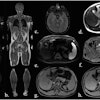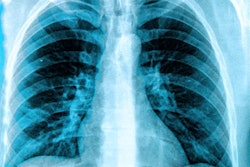
In a face-off between CT lung cancer screening trials, the protocol used to analyze lung nodules in the Dutch-Belgian Randomized Lung Cancer Screening (NELSON) trial proved more sensitive than that used in the U.S. National Lung Screening Trial (NLST).
That's according to research presented on August 7 at the International Association for the Study of Lung Cancer (IASLC) World Conference on Lung Cancer (WCLC) 2022 in Vienna. In the presentation, researchers from Erasmus University Medical Center Rotterdam said that the NELSON protocol may increase the benefits of lung cancer screening, particularly for early-stage cancers, while reducing unnecessary follow-up procedures.
 Koen de Nijs.
Koen de Nijs."We hope that these results will help inform decisions on nodule management in ongoing and future screening programs," lead researcher Koen de Nijs, a PhD student at Erasmus, told AuntMinnieEurope.com. "Our results suggest that volume-based nodule management is likely to increase the benefits of lung cancer screening programmes."
Both NELSON and NLST were landmark research studies that demonstrated the effectiveness of CT lung cancer screening for high-risk individuals. NELSON revealed a reduction in lung cancer mortality of 24% for screening with CT, compared to a 20% reduction in the NLST. But the trials differed in study population and trial design, he noted.
Specifically, the NELSON trial used a nodule management protocol that incorporated nodule volume and quantified volume growth as opposed to nodule diameter for determining whether to conduct follow-up procedures. The Erasmus group, therefore, evaluated how the difference in nodule management protocols affected CT sensitivity across stages and histology in the trials.
Using the MISCAN-Lung model, previously used to evaluate results from the NLST, to evaluate NELSON's outcomes, the group found that the sensitivity in NELSON was estimated to be higher across all stages compared with the NLST. The model reproduced lung cancer incidence and mortality by method of detection (clinical or screen-detected), sex, histology, and stage; the researchers evaluated potential differences in CT sensitivity by stage and histology, accounting for characteristics of the study population, trial design, and epidemiology in each trial.
The comparison between the trials was as follows:
| Sensitivity of CT lung cancer screening protocols | ||
| Sensitivity by cancer type | NLST | NELSON |
| Early-stage adenocarcinoma, stage 1A | 57% | 73% |
| Early-stage adenocarcinoma, stage 1B | 64% | 90% |
| Squamous cell carcinoma, stage 2 | 39% | 75% |
Specificity with the NELSON protocol was also superior to that of NLST. The Erasmus researchers stated that NELSON's volumetric-based technique for evaluating lung nodules was superior to the technique used with NLST. Model-based comparison of the NELSON and NLST suggests that the differences in screening effectiveness may be explained by differences in the nodule management protocols, they pointed out.
Overall, they hope the new research will have an influence on nodule management protocol.
"Volume-based measurement may require investment and training, such as for the use of computer-aided detection systems. However, in a comparison of the volume-based NELSON trial and the diameter-based NLST, we find considerable differences in the probability of the detection of disease at an early stage," said de Nijs.
The results may also have an impact on recommendations of future screening programs, he added. "Many published estimates of cost-effectiveness are still based on the results of the NLST. Any program employing volume-based nodule management may see greater benefits from the required investment, improving the cost-effectiveness of lung cancer screening on a population scale."



















